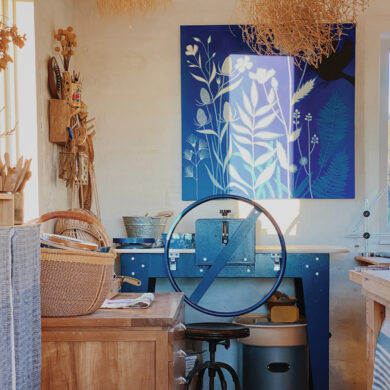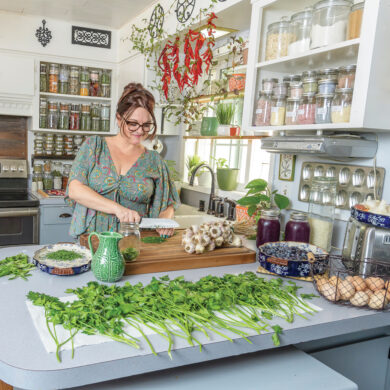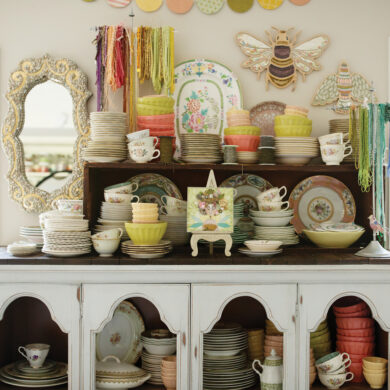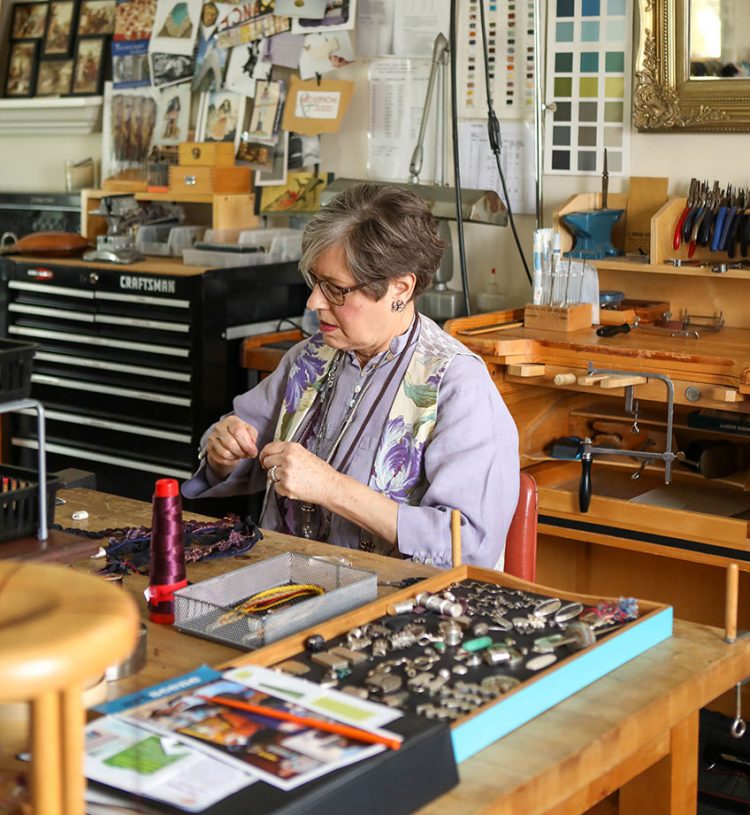
I was born in northern New Jersey and at the age of three moved with my parents and brother to the town of Clarksville, New York near the city of Albany. We lived in a home on the top of a mountain with an expansive view overlooking the valleys below. It was rural, isolated and peaceful. The woods and fields were my playgrounds, and books were my friends. We moved to the Hudson Valley when I was twelve, and I have lived here ever since.
I have always loved learning craft techniques/projects from books and craft magazines. I remember decorating my book report covers for school with elaborate embellishments. The first specific item I can remember creating was my plaster of Paris 5-year-old hand mold for a kindergarten pie tin project. I also recall a class self-portrait I made which I was asked to do over; I had initially colored my eyes red—the teacher did not appreciate my creative impulse! Still, I carried on my appreciation for creativity through the tradition of stitching in 3rd grade when I learned to knit and later, at the age of 10, learned to use a sewing machine while in my local 4-H club.
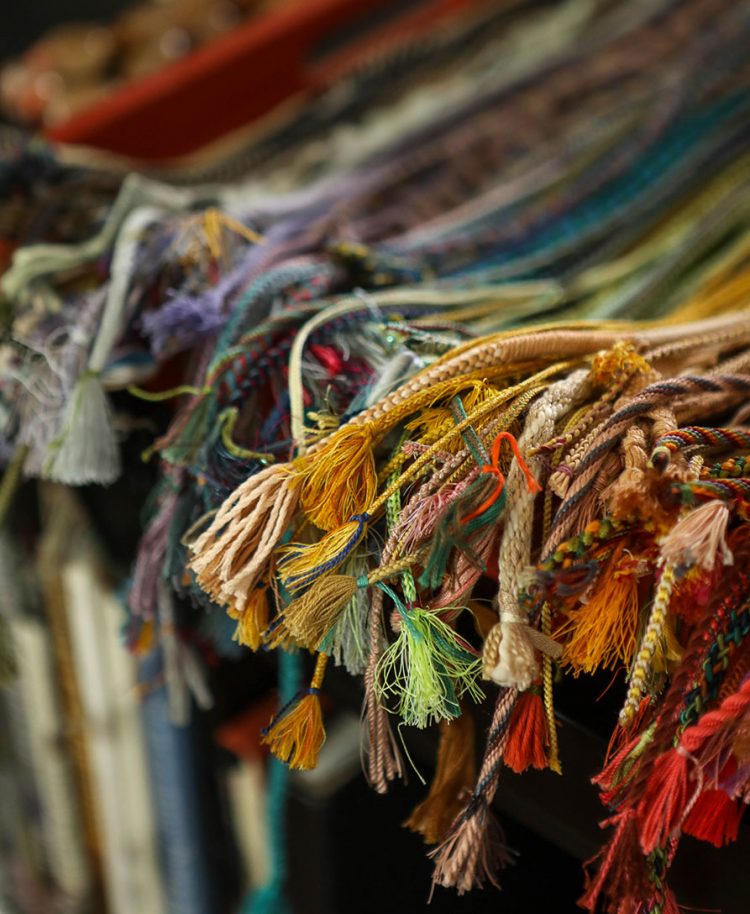
Fast-forward to my graduating from college with a degree in education and soon after earning my Master of Arts degree in early childhood education. I became a classroom teacher for 14 years where all of my arts and crafts skills were widely put to use. I wanted, however, for my passion for art to play a more major role in my life so became a certified K-12 art teacher and for six years solely taught art to 500 K-2 students. It required tremendous stamina, but the artwork of uninhibited young children and their excitement at creating it was spectacular and inspiring. They developed confidence in their abilities, and I was gratified to see that I had a significant positive influence in fostering a creative community.
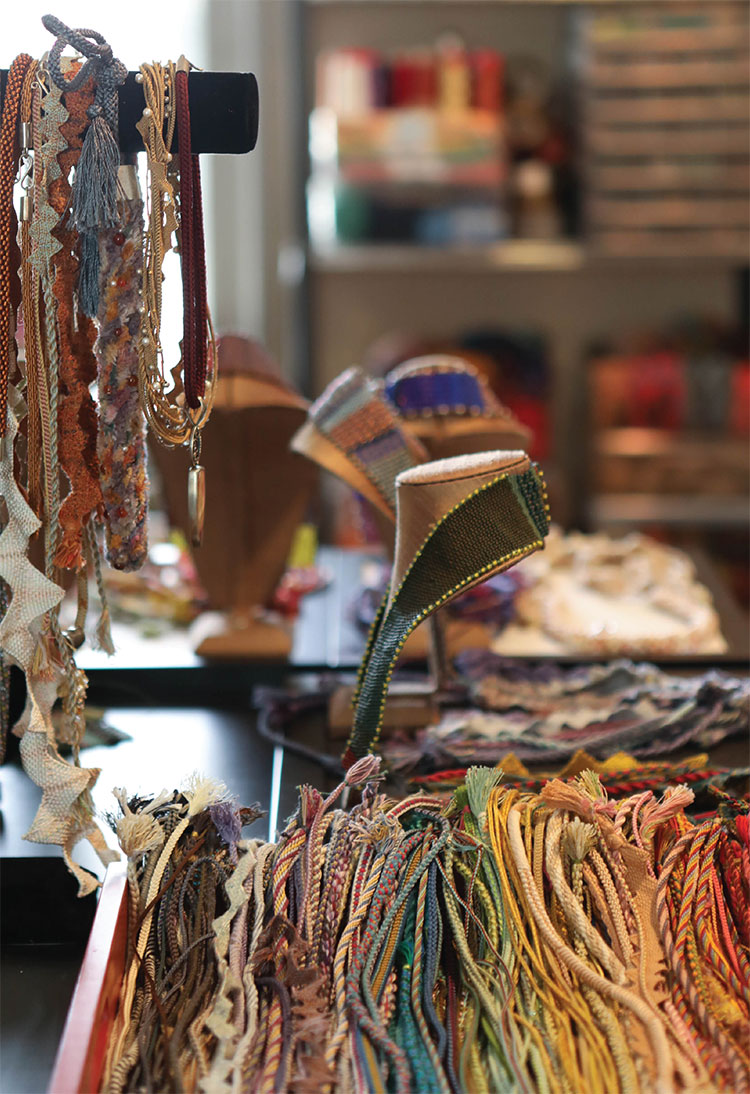
I frequently have told my young art students that artists are the creative thinkers of the world, always trying to work through the challenges and decision-making process necessary in their work.
The community has regularly played a major role in my life and work with two very distinct definitions for me; one being my craft artist community and the other being the broader community at large. My craft artist community involvement began very long ago when I was teaching and my fiber work was in its early stages. I also joined professional organizations from the beginning of my teaching career and continue to do so presently. I attend conferences and workshops throughout the United States and beyond. Studio work can be isolating and solitary and participating in community organizations has allowed me to connect with a broad range of people.
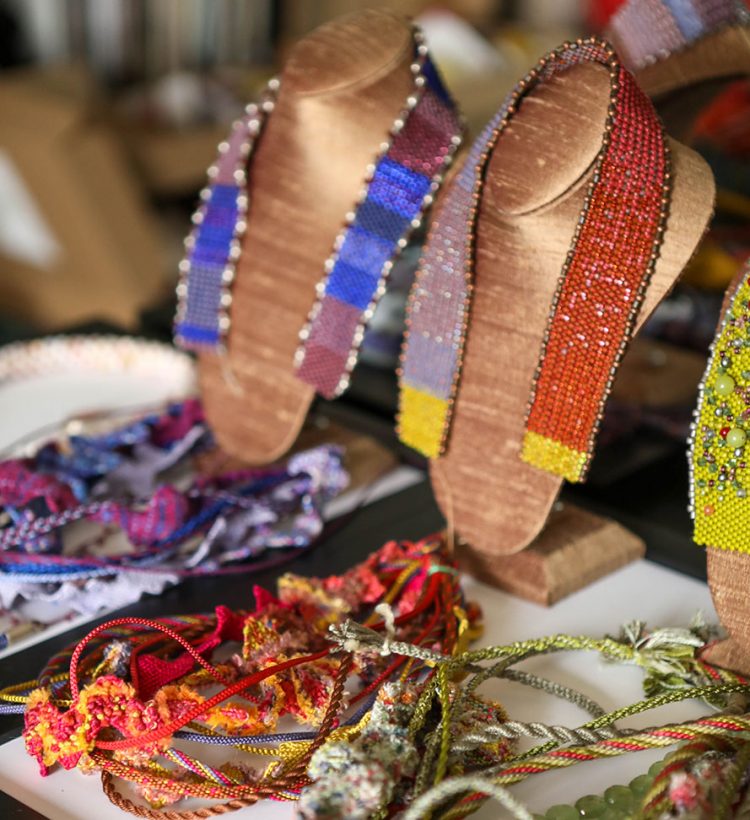
Today, I work from my studio in a Dutch colonial revival home that I share with my husband, Eli. It is located in a residential neighborhood of the historic city of Kingston, set on four acres 90 miles north of New York City. I am fortunate where I live to have the convenience of city life accessibility set within a robust natural environment. Our fields and pond bring daily sightings of wildlife. The lowlands of our back property have been farmed for millennia, and it is here where Native peoples planted maize and squash, as the rich soil from the Esopus Creek made it very fertile. This land now provides me with a thriving dye garden where I plant Japanese indigo, marigolds, zinnias and more.
“Dance first. Think later. It’s the natural order.”
— Samuel Beckett
My studio functions as both my fiber studio and my jewelry-making studio. Several years ago, we renovated the space so that I would have a dedicated workplace. We had bookshelves and cabinets built and a pine floor and heating unit installed. Sometimes I spill out into my kitchen or dining room mainly because I am always working on several pieces at once. The convenience of having my studio within my home allows me to work at any time throughout the day.
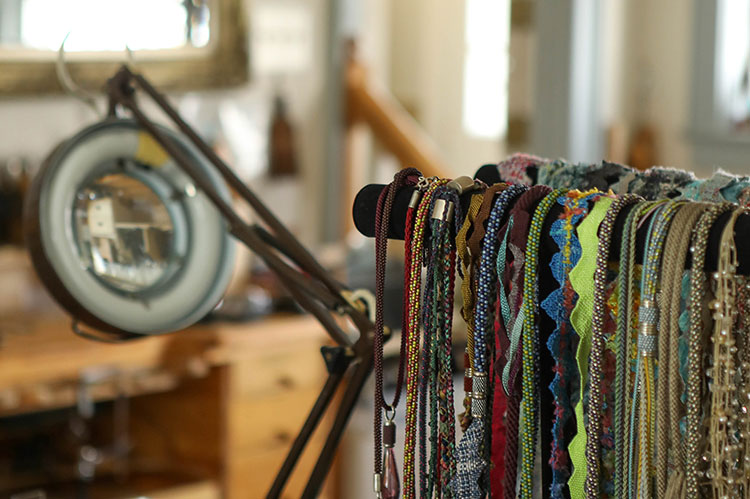
Even though I have a good-sized studio, I’m not able to have all my materials and projects in view. To compensate for that, I use shelving and containers for storage and stack many supplies and works in progress. I often reevaluate the efficiency of my studio and rearrange equipment or supplies when necessary. Everything is organized, accessible and labeled. It’s important for me to have ease and flow to my work; if I have to stop and search for something inside a cabinet, it takes valuable time away from what I’m doing.
I think it also helps your creative spirit to surround yourself with what inspires you. I have books and posters along with items from my travels on the walls and shelves of my studio. All of it connects me to the creatives I admire and encourages me to continue my practice.
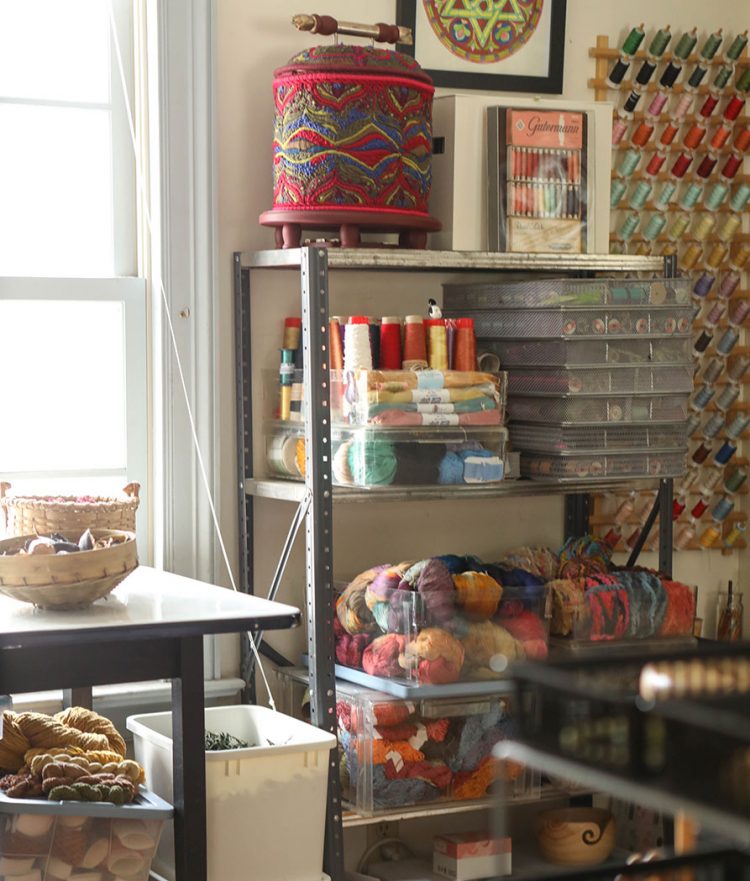
My biggest challenge with my studio and creating has been establishing and maintaining a disciplined work schedule. Having a studio in my home has the advantage of convenience. Along with that, however, is the reality that I can be distracted by household chores or other activities. I’m not far from my laundry room or kitchen, and it’s so easy to leave my studio and get involved with other responsibilities. Working in a home studio can be isolating so it’s tempting to answer the phone when a friend calls to talk or offer an invitation. I am proud to say that I have now successfully established a work routine that supports my creative endeavors. I schedule workouts, meetings and appointments for late afternoon so that my prime morning work time is uninterrupted. I don’t answer my personal phone during work hours and my coffee and lunch breaks are minimal.
I have endless sources of inspiration and occasionally have to rein myself in and focus so that my work stays true to my vision. I’m particularly drawn in by the curves of pathways, the contours of mountains or the buds and plants emerging from dormancy. The architectural details of doorways, arches, corbels, hardware, etc. attract my attention as well. The work of other creatives and cultures consistently inspires me, especially the work of Italian, Scandinavian, Japanese and Israeli artisans, as I’m awestruck by the skills and work of other artists.
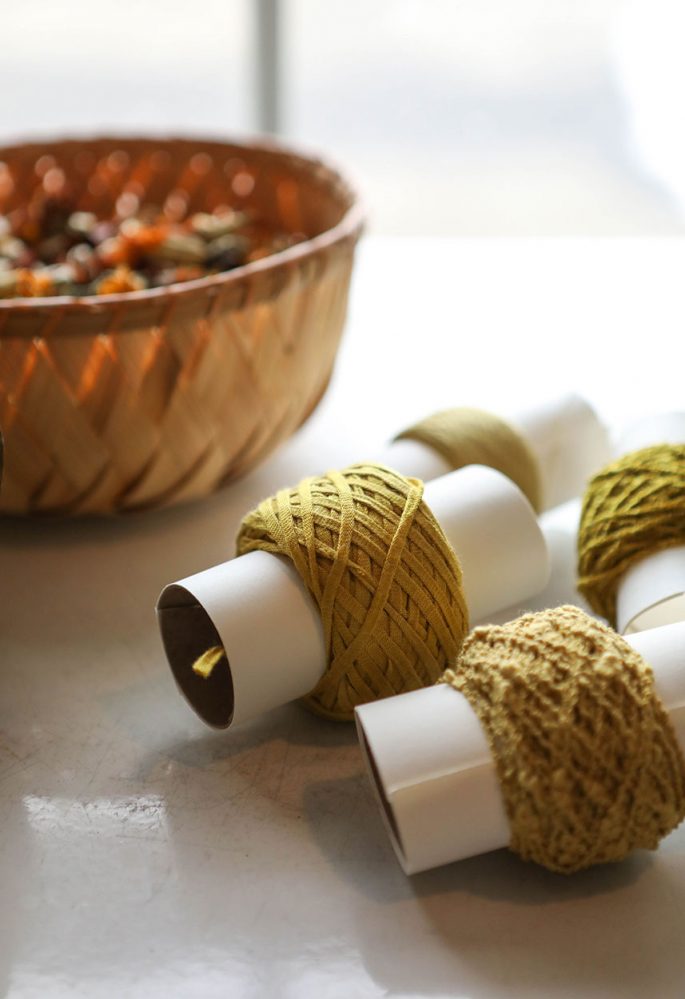
My style came from years of exploration with ideas and materials. It has taken me a very long time to find a consistent voice. During my twenty-year teaching career, my work was directed by my teaching schedule, and I explored many techniques including spinning, dyeing, felt making, knitting and crochet. My style evolves with every new skill or material I acquire, but it has become for me the balance between disparate materials of fibers and metals; the hard and soft, the masculine and feminine and the balance of simplicity and ornamentation. I am particularly driven by my love and obsession with color. It’s an element that truly excites and delivers a powerful, emotional response. Texture and pattern are significant influences as well and often determine the direction in which my work develops.
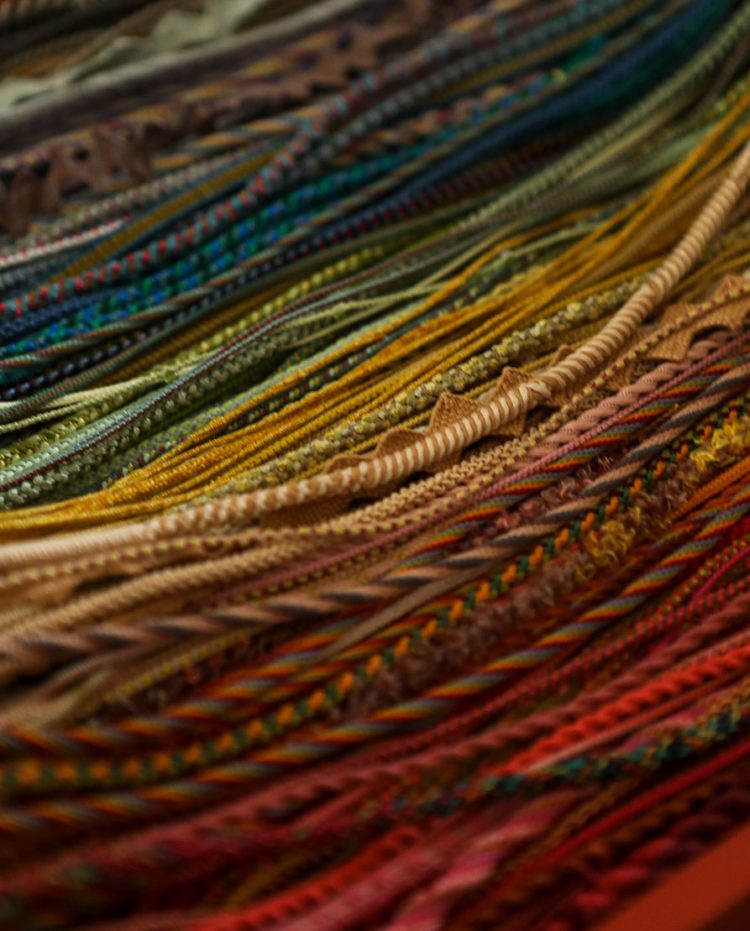
Creativity is my go-to strategy when faced with life’s challenges. It’s a way to think outside the box to determine how to move forward when I’m stuck in a difficult situation. I’m a visual person so this is how I process information; I react emotionally to the world through my art. I’m also very tactile. I respectfully touch things that I’m attracted to, especially textiles and fibers…although it could be the bark of a tree or sand or water; it’s how I experience and appreciate them. Being creative in my work and my home environment with cooking, gardening and decorating gives me comfort and satisfaction. And, being orderly gives me a sense of control and calm.
Creativity can be expressed in many ways. It’s how you dress, how you decorate your living space, how you cook and serve your meals. It’s how you express yourself and how you communicate.

I was born in northern New Jersey and at the age of three moved with my parents and brother to the town of Clarksville, New York near the city of Albany. We lived in a home on the top of a mountain with an expansive view overlooking the valleys below. It was rural, isolated and peaceful. The woods and fields were my playgrounds, and books were my friends. We moved to the Hudson Valley when I was twelve, and I have lived here ever since.
I have always loved learning craft techniques/projects from books and craft magazines. I remember decorating my book report covers for school with elaborate embellishments. The first specific item I can remember creating was my plaster of Paris 5-year-old hand mold for a kindergarten pie tin project. I also recall a class self-portrait I made which I was asked to do over; I had initially colored my eyes red—the teacher did not appreciate my creative impulse! Still, I carried on my appreciation for creativity through the tradition of stitching in 3rd grade when I learned to knit and later, at the age of 10, learned to use a sewing machine while in my local 4-H club.

Fast-forward to my graduating from college with a degree in education and soon after earning my Master of Arts degree in early childhood education. I became a classroom teacher for 14 years where all of my arts and crafts skills were widely put to use. I wanted, however, for my passion for art to play a more major role in my life so became a certified K-12 art teacher and for six years solely taught art to 500 K-2 students. It required tremendous stamina, but the artwork of uninhibited young children and their excitement at creating it was spectacular and inspiring. They developed confidence in their abilities, and I was gratified to see that I had a significant positive influence in fostering a creative community.

I frequently have told my young art students that artists are the creative thinkers of the world, always trying to work through the challenges and decision-making process necessary in their work.
The community has regularly played a major role in my life and work with two very distinct definitions for me; one being my craft artist community and the other being the broader community at large. My craft artist community involvement began very long ago when I was teaching and my fiber work was in its early stages. I also joined professional organizations from the beginning of my teaching career and continue to do so presently. I attend conferences and workshops throughout the United States and beyond. Studio work can be isolating and solitary and participating in community organizations has allowed me to connect with a broad range of people.

Today, I work from my studio in a Dutch colonial revival home that I share with my husband, Eli. It is located in a residential neighborhood of the historic city of Kingston, set on four acres 90 miles north of New York City. I am fortunate where I live to have the convenience of city life accessibility set within a robust natural environment. Our fields and pond bring daily sightings of wildlife. The lowlands of our back property have been farmed for millennia, and it is here where Native peoples planted maize and squash, as the rich soil from the Esopus Creek made it very fertile. This land now provides me with a thriving dye garden where I plant Japanese indigo, marigolds, zinnias and more.
“Dance first. Think later. It’s the natural order.”
— Samuel Beckett
My studio functions as both my fiber studio and my jewelry-making studio. Several years ago, we renovated the space so that I would have a dedicated workplace. We had bookshelves and cabinets built and a pine floor and heating unit installed. Sometimes I spill out into my kitchen or dining room mainly because I am always working on several pieces at once. The convenience of having my studio within my home allows me to work at any time throughout the day.

Even though I have a good-sized studio, I’m not able to have all my materials and projects in view. To compensate for that, I use shelving and containers for storage and stack many supplies and works in progress. I often reevaluate the efficiency of my studio and rearrange equipment or supplies when necessary. Everything is organized, accessible and labeled. It’s important for me to have ease and flow to my work; if I have to stop and search for something inside a cabinet, it takes valuable time away from what I’m doing.
I think it also helps your creative spirit to surround yourself with what inspires you. I have books and posters along with items from my travels on the walls and shelves of my studio. All of it connects me to the creatives I admire and encourages me to continue my practice.

My biggest challenge with my studio and creating has been establishing and maintaining a disciplined work schedule. Having a studio in my home has the advantage of convenience. Along with that, however, is the reality that I can be distracted by household chores or other activities. I’m not far from my laundry room or kitchen, and it’s so easy to leave my studio and get involved with other responsibilities. Working in a home studio can be isolating so it’s tempting to answer the phone when a friend calls to talk or offer an invitation. I am proud to say that I have now successfully established a work routine that supports my creative endeavors. I schedule workouts, meetings and appointments for late afternoon so that my prime morning work time is uninterrupted. I don’t answer my personal phone during work hours and my coffee and lunch breaks are minimal.
I have endless sources of inspiration and occasionally have to rein myself in and focus so that my work stays true to my vision. I’m particularly drawn in by the curves of pathways, the contours of mountains or the buds and plants emerging from dormancy. The architectural details of doorways, arches, corbels, hardware, etc. attract my attention as well. The work of other creatives and cultures consistently inspires me, especially the work of Italian, Scandinavian, Japanese and Israeli artisans, as I’m awestruck by the skills and work of other artists.

My style came from years of exploration with ideas and materials. It has taken me a very long time to find a consistent voice. During my twenty-year teaching career, my work was directed by my teaching schedule, and I explored many techniques including spinning, dyeing, felt making, knitting and crochet. My style evolves with every new skill or material I acquire, but it has become for me the balance between disparate materials of fibers and metals; the hard and soft, the masculine and feminine and the balance of simplicity and ornamentation. I am particularly driven by my love and obsession with color. It’s an element that truly excites and delivers a powerful, emotional response. Texture and pattern are significant influences as well and often determine the direction in which my work develops.

Creativity is my go-to strategy when faced with life’s challenges. It’s a way to think outside the box to determine how to move forward when I’m stuck in a difficult situation. I’m a visual person so this is how I process information; I react emotionally to the world through my art. I’m also very tactile. I respectfully touch things that I’m attracted to, especially textiles and fibers…although it could be the bark of a tree or sand or water; it’s how I experience and appreciate them. Being creative in my work and my home environment with cooking, gardening and decorating gives me comfort and satisfaction. And, being orderly gives me a sense of control and calm.
Creativity can be expressed in many ways. It’s how you dress, how you decorate your living space, how you cook and serve your meals. It’s how you express yourself and how you communicate.









